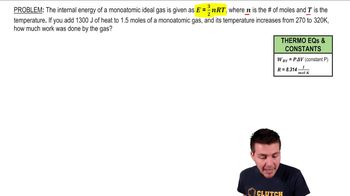Here are the essential concepts you must grasp in order to answer the question correctly.
First Law of Thermodynamics
The First Law of Thermodynamics states that energy cannot be created or destroyed, only transformed. In the context of thermodynamic processes, it relates the change in internal energy of a system to the heat added to the system and the work done by the system. Mathematically, it is expressed as ΔU = Q - W, where ΔU is the change in internal energy, Q is the heat added, and W is the work done by the system.
Recommended video:
The First Law of Thermodynamics
Work Done by a Gas
When a gas expands at constant pressure, the work done by the gas can be calculated using the formula W = PΔV, where P is the pressure and ΔV is the change in volume. In this scenario, the gas expands from 400 cm³ to 800 cm³, resulting in a volume change of 400 cm³. This work done by the gas is crucial for determining the pressure when combined with the heat energy transferred.
Recommended video:
Calculating Work Done on Monoatomic Gas
Ideal Gas Law
The Ideal Gas Law relates the pressure, volume, temperature, and number of moles of an ideal gas through the equation PV = nRT. In this problem, while the temperature is not explicitly given, the relationship between pressure and volume during the expansion at constant pressure can be utilized to find the pressure. Understanding this law helps in analyzing the behavior of gases under various conditions.
Recommended video:
Ideal Gases and the Ideal Gas Law
 Knight Calc 5th Edition
Knight Calc 5th Edition Ch 19: Work, Heat, and the First Law of Thermodynamics
Ch 19: Work, Heat, and the First Law of Thermodynamics Problem 19
Problem 19


